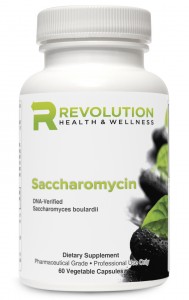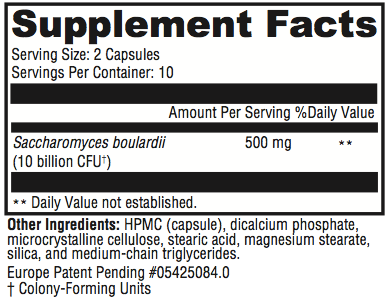Saccharomycin

Saccharomyces boulardii (S. boulardii) is a natural, non-pathogenic yeast that may help support and maintain the healthy ecology of the small and large intestines. In a 2010 systematic review and meta-analysis of 31 randomized placebo-controlled treatment arms in 27 trials comprising 5029 adults, “S boulardii was found to be significantly efficacious and safe in 84% of those treatment arms.”[1] A study also suggested that S boulardii can be used safely and effectively in children three months and older.[2] A double-blind, randomized, placebo controlled study of children ages 3-59 months produced statistically significant positive results suggesting that S boulardii may play an important role in supporting normal gastrointestinal function in young children.*[3]
Extensively researched and published in European and American peer-reviewed journals, Saccharomyces boulardii appears to function through several mechanisms of action. With regard to maintaining normal GI function and transit time, research suggests that S boulardii secretes a protease that may assist in directly degrading bacterial toxins and stimulating antibody production against those toxins.[4-6] S boulardii is also believed to support the natural inflammatory response, exert a trophic effect on intestinal mucosa, and positively support the immune system.[3] These actions further support and help maintain the normal health and function of the intestinal brush border.*
This probiotic yeast appears to support normal gastrointestinal flora and integrity[7,8]; promote production of intestinal enzymes and secretory IgA[9]; and support cytokine balance through its effects on IL-8, IL-6, IL-10, NF-kappaB, TNF-alpha, and PPAR-gamma.[6,10,11] Research suggests a role for S. boulardii in the production of health-promoting short-chain fatty acids, including butyrate.*[12] Research suggests that butyrate, in turn, plays an important role in maintaining the integrity, function, and normal flora of the intestines.[13]
Following a multi-dose study in healthy volunteers, the concentration of S boulardii in feces increased rapidly, reaching a steady state by day three in all subjects. Following completion of administration, the S boulardii population declined consistently and was cleared from the bowel within five to seven days, indicating that the probiotic yeast did not permanently colonize the gastrointestinal tract.[14] Saccharomycin provides 10 billion colony-forming units of S boulardii in a two-capsule dose.*
Directions
Take 1-2 capsules per day (unless otherwise instructed). I generally recommend starting with 1 capsule but, if your case is more severe, you may need 2 capsules per day.
References
- McFarland LV. Systematic review and meta-analysis of Saccharomyces boulardii in adult patients. World J Gastroenterol. 2010 May 14;16(18):2202-22. [PMID: 20458757]
- Vandenplas Y, Brunser O, Szajewska H. Saccharomyces boulardii in childhood. Eur J Pediatr. 2009 Mar;168(3):253-65. Review. [PMID: 19096876]
- Riaz M, Alam S, Malik A, et al. Efficacy and Safety of Saccharomyces boulardii in Acute Childhood Diarrhea: A Double Blind Randomised Controlled Trial. Indian J Pediatr. 2011 Oct 14. [PMID: 21997865]
- Can M, Beşirbellioglu BA, Avci IY, et al. Prophylactic Saccharomyces boulardii in the prevention of antibiotic-associated diarrhea: a prospective study. Med Sci Monit. 2006 Apr;12(4):PI19-22. [PMID: 16572062]
- Castagliuolo I, Riegler MF, Valenick L, et al. Saccharomyces boulardii protease inhibits the effects of Clostridium difficile toxins A and B in human colonic mucosa. Infect Immun. 1999 Jan;67(1):302-7. [PMID: 9864230]
- Im E, Pothoulakis C. [Recent advances in Saccharomyces boulardii research]. Gastroenterol Clin Biol. 2010 Sep;34 Suppl 1:S62-70. Review. French. [PMID: 20889007]
- Krasowska A, Murzyn A, Dyjankiewicz A, et al. The antagonistic effect of Saccharomyces boulardii on Candida albicans filamentation, adhesion and biofilm formation. FEMS Yeast Res. 2009 Dec;9(8):1312-21. [PMID: 19732158]
- Saccharomyces boulardii. Professional Monograph. Natural Standard Database http://naturalstandard.com/databases/herbssupplements/ sboulardii.asp. Accessed February 14, 2012.
- Buts JP, Bernasconi P, Vaerman JP, et al. Stimulation of secretory IgA and secretory component of immunoglobulins in small intestine of rats treated with Saccharomyces boulardii. Dig Dis Sci. 1990 Feb;35(2):251-6. [PMID: 2302983]
- Dahan S, Dalmasso G, Imbert V, et al. Saccharomyces boulardii interferes with enterohemorrhagic Escherichia coli-induced signaling pathways in T84 cells. Infect Immun. 2003 Feb;71(2):766-73. [PMID: 12540556]
- Pothoulakis C. Review article: anti-inflammatory mechanisms of action of Saccharomyces boulardii. Aliment Pharmacol Ther. 2009 Oct 15;30(8):826-33. Review. [PMID: 19706150]
- Schneider SM, Girard-Pipau F, Filippi J, et al. Effects of Saccharomyces boulardii on fecal short-chain fatty acids and microflora in patients on long-term total enteral nutrition. World J Gastroenterol. 2005 Oct 21;11(39):6165-9. [PMID: 16273644]
- Lewis K, Lutgendorff F, Phan V, et al. Enhanced translocation of bacteria across metabolically stressed epithelia is reduced by butyrate. Inflamm Bowel Dis. 2010 Jul;16(7):1138-48. [PMID: 20024905]
- Blehaut H, Massot J, Elmer GW, et al. Disposition kinetics of Saccharomyces boulardii in man and rat. Biopharm Drug Dispos. 1989 Jul- Aug;10(4):353-64. [PMID: 2758101]








